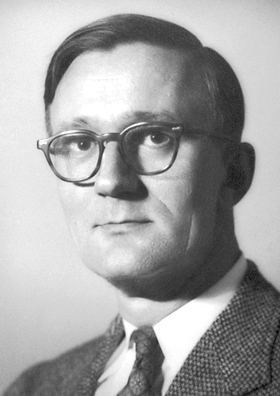Polykarp Kusch facts for kids
Quick facts for kids
Polykarp Kusch
|
|
|---|---|
 |
|
| Born | January 26, 1911 Blankenburg, District of Blankenburg, Duchy of Brunswick, German Empire
|
| Died | March 20, 1993 (aged 82) |
| Alma mater | University of Illinois Case Western Reserve University |
| Known for | Measured the magnetic moment of the electron |
| Awards | Nobel Prize in Physics (1955) |
| Scientific career | |
| Institutions | University of Texas at Dallas Columbia University |
| Thesis | The molecular spectra of caesium and rubidium (1936) |
| Doctoral advisor | Francis Wheeler Loomis |
| Doctoral students | Eugene D. Commins Gordon Gould Sheldon Schultz |
Polykarp Kusch (born January 26, 1911 – died March 20, 1993) was a famous physicist from America, originally from Germany. In 1955, he won half of the Nobel Prize in Physics. He earned this award for accurately measuring the magnetic moment of the electron. He found that the electron's magnetic moment was slightly larger than what scientists expected. This discovery was very important. It helped lead to new ideas and changes in a field of physics called quantum electrodynamics. Another scientist, Willis Lamb, won the other half of the 1955 Nobel Prize for his work on the hydrogen atom.
Early Life and Education
Polykarp Kusch was born in Blankenburg, Germany. His father, John Mathias Kusch, was a Lutheran missionary. His mother was Henrietta van der Haas.
In 1912, when Polykarp was very young, his family moved to the United States. He became an American citizen in 1922. After finishing grade school, he went to the Case Institute of Technology in Cleveland, Ohio. This school is now known as Case Western Reserve University. He studied physics there.
Kusch earned his bachelor's degree in science in 1931. Then, he went to the University of Illinois at Urbana-Champaign. He received his master's degree from there in 1933. He continued his studies at the same university. He worked on his Ph.D. under the guidance of Professor F. Wheeler Loomis. In 1936, he finished his Ph.D. thesis, which was about "The Molecular Spectrum of Caesium and Rubidium."
In 1935, before moving to the University of Minnesota, Kusch married Edith Starr Roberts. They had three daughters together.
Career and Discoveries
After his studies, Kusch moved to New York City. From 1937, he worked as a professor at Columbia University. He stayed there for many years. He even served as the university's provost for a while. Later, he moved to the new University of Texas at Dallas.
At Columbia, Kusch worked with a famous scientist named Isidor Isaac Rabi. They studied molecules using special techniques. During this time, Kusch made his big discovery: the electron's anomalous magnetic moment. This means he found that the electron's magnetic property was a bit different from what was predicted. This discovery was a huge step forward in understanding how tiny particles behave.
After this, Kusch continued to make many measurements of magnetic moments. He also studied something called hyperfine structure. His research also expanded into chemical physics. He kept publishing important studies using molecular beams.
While at Columbia, Polykarp Kusch was the doctoral supervisor for Gordon Gould. Gordon Gould later became famous as the inventor of the laser.
Honors and Legacy
Polykarp Kusch received many honors for his important work. He became a fellow of the American Physical Society in 1940. In 1959, he was also made a fellow of the American Academy of Arts and Sciences. In 1956, he was chosen to be a member of the National Academy of Sciences. These are all very respected groups for scientists.
Kusch's first wife, Edith, passed away in 1959. The next year, in 1960, he married Betty Pezzoni. They had two daughters together.
Today, Polykarp Kusch is remembered in several ways. Kusch House is a dormitory for students at Case Western Reserve University in Cleveland, Ohio. It is named after him. The University of Texas at Dallas also has a Polykarp Kusch Auditorium. There is a special plaque there to honor him. His second wife, Betty, passed away in 2003.
See also
 In Spanish: Polykarp Kusch para niños
In Spanish: Polykarp Kusch para niños

